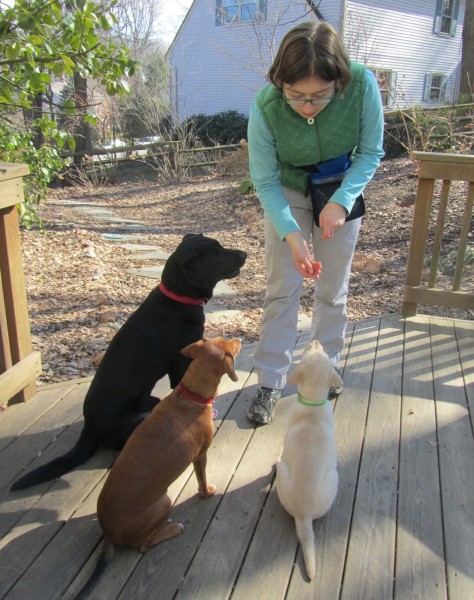 Since Winnie doesn’t drive yet, I’ve been to nearly all of her dog training classes. Though occasionally I’ll sit on the perimeter of the room working on my own projects, most often I watch or help out with class. I’ve even worked dogs in class now and then, so I’m kind of familiar with the drill.
Since Winnie doesn’t drive yet, I’ve been to nearly all of her dog training classes. Though occasionally I’ll sit on the perimeter of the room working on my own projects, most often I watch or help out with class. I’ve even worked dogs in class now and then, so I’m kind of familiar with the drill.
For the first few months of puppy raising you go to class every week and class is as much for the raisers as it is for the puppies. You learn how to teach your puppy the basic skills – sit, down, stand, etc. as well as learn how to properly socialize a dog. After the initial puppy stage, you go to class every other week, giving you more time to practice your skills out in the world between classes.
Oak is Winnie’s fifth puppy for Guiding Eyes for the Blind and since he’s only three months old, we’re in the thick of weekly classes. But this time around, things have taken a decidedly different turn in the philosophy of early puppy training.
While we’ve always learned about the “Think and Learn Zone,” that state of mind you work toward putting your puppy in and keeping him there, it’s always come after the basic command functions are taught. It’s been the approach of “now that your puppies have their basic skills, we need to work on keeping them in a calm and focused state.”
But this go round they’re flipping that model – more class time is spent on helping puppies learn to calm down, focus, and get in a quiet frame of mind, while less time is spent on teaching obedience and skills. In other words, they’re teaching raisers how to get the puppies into and stay in the “Think and Learn Zone” rather that focusing on initial skills mastery. Once the puppies can stay calm and focused, teaching them their basic commands is a snap. Set the right mental foundation and skills development is quick and easy.
Today it hit me that I’ve been teaching my kids like dogs all along.
Since our very first days of homeschooling, I’ve always maintained our focus on learning how to learn. To this day, even with an 11th grader, a 9th grader and an 8th grader, we still use logic puzzles, games, and the Socratic method (leading the student to find his own answers through a series of questions) every single day. Every day!
Why would I spend so much time on that stuff, rather than vocabulary and formulas and historical timelines? There are no games on the SATs, that’s for sure.
Because we’re rarely taught how to actually learn.
And knowing how to learn is the most valuable life skill there is.
Sure, kids today are chock-full of information – enough to ace the AP Microbiology, the ACTs, and the SAT Subject Test exams, all of them (and more!). We live in such an information-rich society with facts and figures at our fingertips within seconds. The information is all there and readily available, so why not ask kids to learn as much of it as they can?
Because the truth is, they’re not really learning it. They’re retaining enough of it to get through the exam and then dumping it.
No one can possibly retain all that information long-term, and nor do they need to.
What they do need to know, however, is how to ask probing questions. How to dig for additional information. How to draw parallels between events and circumstances and developments. How to ask why and how to know when to stop asking why.
In other words, kids need to learn to live in the “Think and Learn Zone,” not in the cramming for exams and spitting it all out in an hour zone.
And that’s why I teach my kids the exact same way as we train our dogs.
Because whether you’re a dog or child, thinking and learning trumps obedience any day.

